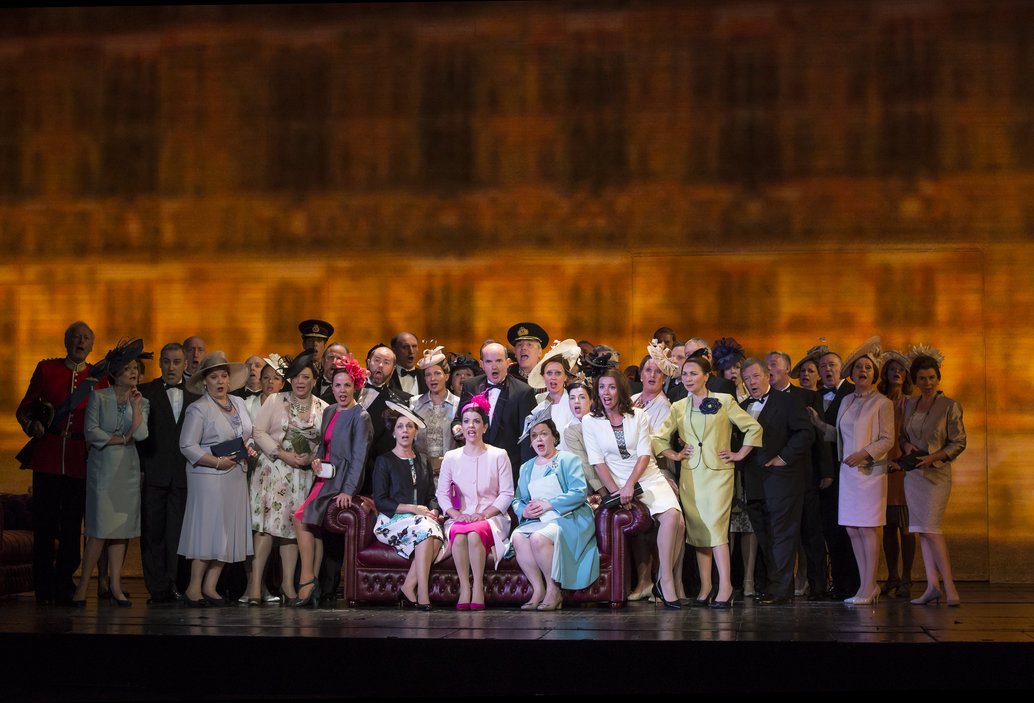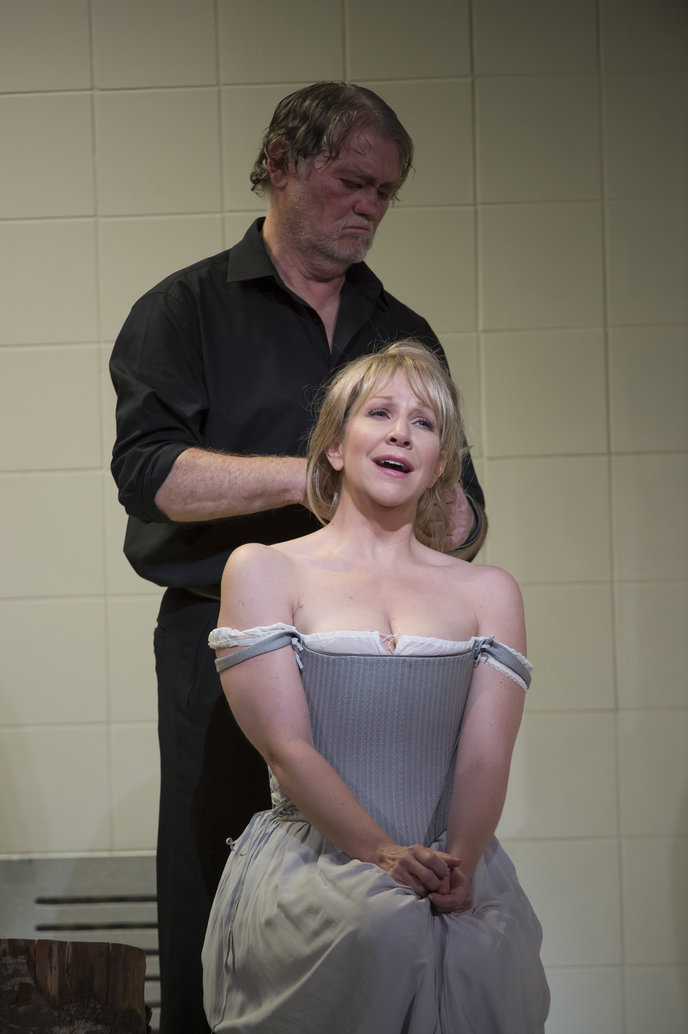The Royal Opera House’s Maria Stuarda is the third major production of Donizetti’s historical opera in less than two years. First there was David McVicar’s kitschy-traditional production for the Met, then there was Rudolf Frey’s baffling concept-drama at Welsh National Opera, and now directors Moshe Leiser and Patrice Caurier add their voices to a conversation still trying to make sense of these passionate warring queens with their determinedly dispassionate music.
The historical specificities of Donizetti’s story make it particularly resistant to directorial innovation. Whichever way you play it there’s still an awful lot of talk of axes and beheading, Catholicism and the English aristocracy. Leiser and Caurier get around this problem neatly by juxtaposing eras in their staging – keeping the two queens in the 16th century, but framing them with a contemporary cast and set.
It’s a collision of contexts that takes a while to settle. Elizabeth’s opening speech, delivered at what seems to be a royal dinner function, lacks gravitas, and her opening aria risks losing its emotional simplicity in the confusion of ideas. But, given time, this collision of worlds proves itself both flexible and surprisingly effective.
 Just as Donizetti’s music sets the two women apart from everyone else on stage, so their dress keeps them isolated (physically, in the case of Elizabeth’s exaggerated farthingale) and out of sync with their surroundings. These are women playing at the men’s game of politics, condemned to failure whatever their choices, hindered as they are by outmoded and restrictive values and costume. Where McVicar’s visual fidelity risked Python-esque parody at times, this anachronistic setting provokes new reactions to a familiar story. Mary’s wipe-clean contemporary execution chamber is particularly effective in its refusal to romanticise.
Just as Donizetti’s music sets the two women apart from everyone else on stage, so their dress keeps them isolated (physically, in the case of Elizabeth’s exaggerated farthingale) and out of sync with their surroundings. These are women playing at the men’s game of politics, condemned to failure whatever their choices, hindered as they are by outmoded and restrictive values and costume. Where McVicar’s visual fidelity risked Python-esque parody at times, this anachronistic setting provokes new reactions to a familiar story. Mary’s wipe-clean contemporary execution chamber is particularly effective in its refusal to romanticise.
What the Royal Opera’s production and McVicar’s at the Met have in common is of course Joyce DiDonato in the title role. What the Royal Opera have that the Met didn’t, however, is the extra time for the role to settle and grow for DiDonato (pictured below with Peter Dineen). There’s a spontaneity to her ornamentation here that is less embellishment than organic emotional outpouring, connecting absolutely with body and mind. Her tone is endlessly flexible, colouring Donizetti’s four-square phrases with unexpected shades and stretching the predictable arc of his melodies into shapes that are at once unfamiliar and completely inevitable. It’s a performance that would batter its way into life on recording, and in the flesh is deeply and seriously moving.
 DiDonato’s intensity is pitted here against the bel canto agility of Carmen Giannattasio as Elisabetta. It’s a shame that visually the directors load the dice so completely against this caricature of a queen, because it unbalances an inequality that is already finely drawn in Donizetti’s writing. Where dignity and passion dominate for Maria, Elisabetta’s writing is all virtuosic tantrums and musical pique – beautiful, certainly, but also brittle. Giannattasio carries it off with aplomb, and if she lacks the depth of colour of DiDonato it’s an absence that character forgives, if not actively demands.
DiDonato’s intensity is pitted here against the bel canto agility of Carmen Giannattasio as Elisabetta. It’s a shame that visually the directors load the dice so completely against this caricature of a queen, because it unbalances an inequality that is already finely drawn in Donizetti’s writing. Where dignity and passion dominate for Maria, Elisabetta’s writing is all virtuosic tantrums and musical pique – beautiful, certainly, but also brittle. Giannattasio carries it off with aplomb, and if she lacks the depth of colour of DiDonato it’s an absence that character forgives, if not actively demands.
The men are more than a little eclipsed by such twin dominance, and though I couldn’t help yearning for Joseph Calleja (who sang Leicester in the Deutsche Oper’s recent concert performances of the opera opposite DiDonato and Giannattasio), young Spanish tenor Ismael Jordi made an attractive substitute – silvery bright of tone, if not yet quite grounded and totally Flórez-secure. Matthew Rose’s Talbot is perhaps the better foil for DiDonato however – matching her depth of timbre, and contributing to the quietly devastating impact of the confessional aria.
In the pit, Bertrand de Billy keeps thing moving, drawing some fine playing from brass, especially to balance the chattering brightness of strings and keep the opera from toppling into bel canto self-parody.
There will be those who loathe this new, romance-not-included Stuarda, especially coming hot on the stripper-heels of Manon Lescaut. But where Manon felt meretricious in its provocations, there’s a carefully calculated intent to Leiser and Caurier’s anachronisms that surely insures them against any such accusation. If they can’t quite transform Maria Stuarda into a great opera it’s hard to hold it against them. That they transform it into great Donizetti is achievement enough, and no mean one at that.















Add comment